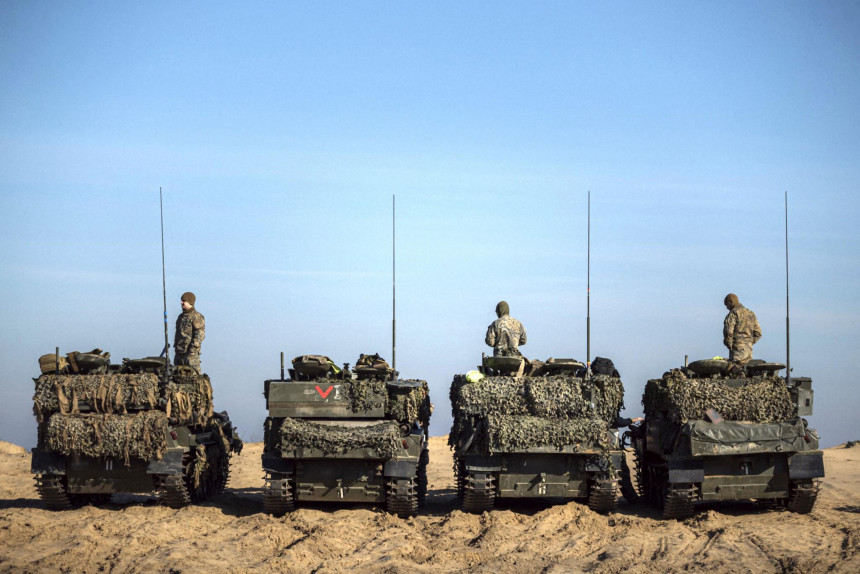Latvia will buy armored vehicles even without Estonians

Estonia's delay in signing the agreement does not affect the further progress of the project, but the development costs of armored vehicles will have to be divided between two project member states - Latvia and Finland. The first six-wheel armored vehicle to be tested could arrive in Latvia next year. Meanwhile, another procurement - the supply of tracked war machines - can be considered successfully completed.
The contract for small tanks was signed with Great Britain in 2014 and provided for the delivery of 123 machines by the end of this year. These machines have been delivered, but last year the next deal was concluded for the delivery of another 82 armored vehicles. Although the defense department was heavily criticized at the beginning of the procurement for purchasing second-hand armored vehicles, it has now proved its worth. Previously, the Latvian army had virtually no armored vehicles, it was necessary to quickly get to a large number of vehicles at relatively low costs. Therefore, a choice was made in favor of used refurbished tracked combat vehicles. The price of the first transaction was 46.6 million euros. 47 used self-propelled howitzers were also purchased from Austria with similar motivation. Cannons on tracks. Now that the army already has some armor equipment at its disposal, the National Armed Forces (NAF) can also focus on purchasing completely new armaments.
Patria - the most suitable for Latvia
Neatkarīgā had already announced Latvia's intention to develop a joint six-wheel armored vehicle model in cooperation with Finland and the company Patria Land Oy. Initially, Estonia also planned to participate in this project, but recently it was reported that due to cost and insufficient benefits, "Estonia is withdrawing from the 6x6 armored vehicles joint project" (in Latvian).
Neatkarīgā asked the Ministry of Defense how this will affect the future course of the project. Here's the explanation:
"The fact that Estonia has not yet signed a contract for the research and development of armored vehicles does not affect the further progress of the project - after the research phase, the participating countries will be able to start negotiations on the purchase of new vehicles. At present, the costs of this agreement will be covered equally by Latvia and Finland. If Estonia decides to sign the agreement, it will have to bear the corresponding additional costs.
The market research done by the Ministry of Defense concluded that the Patria 6x6 armed vehicles offer is currently the most financially advantageous and the most appropriate for Latvian conditions.
Good business for Finns
Thus, formally, Estonia is still a participant in the project, as they signed the technical agreement with Latvia and Finland in the spring. In turn, the project research and development contract can be signed later. Currently, 7.3 million euros for the development of a six-wheel platform will be covered only by Latvia and Finland. To Estonians, this amount - even split between the three parties - seemed too great, but the planned involvement of the industry was insignificant. Estonia's actions, however, seem peculiar, as its armaments already include Pasi armored vehicles manufactured by Patria and they are nearing the end of their life cycle. It is still possible that Estonians will not take part in any development, but in the end they will also buy the same armored vehicles. Latvia however does not belittle co-operation with the Finns.
The vehicle research phase will finish at the end of next year. After testing the first samples, the partner countries will start negotiations on the purchase of 6x6 armored vehicles. The news agency LETA, referring to the Minister of Defense Artis Pabriks, says that the deliveries of armored vehicles could be made in about ten years. If their quality meets the requirements of the Latvian Army, then the machines would be intended not only for the Mechanized Infantry Brigade of the Land Forces, but also for all four National Guard brigades. This means that Latvia as a whole would need several hundred such armored vehicles. The Finnish military industry will get a good deal.
Together they will study airspace protection
In order to save money and achieve armaments compatibility, greater cooperation between NATO nations in the implementation of joint military orders has so far not been very successful. However, this idea has not been abandoned either. A multilateral letter of intent in the field of airspace protection was signed last week. However, it does not yet impose any legal or financial obligations on Member States. It only identifies the existing possibilities:
"Areas of cooperation mentioned in the letter of intent include the identification and development of common requirements for ground-based short- to medium-range air defense systems, joint market research and potential cross-border procurement." Apart from Latvia, this political agreement has been signed by Belgium, Denmark, Germany, Hungary, Italy, the Netherlands, Slovenia, Spain and the United Kingdom.